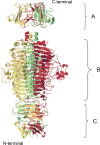Bacteriophage-encoded virion-associated enzymes to overcome the carbohydrate barriers during the infection process
- PMID: 28337580
- PMCID: PMC5380687
- DOI: 10.1007/s00253-017-8224-6
Bacteriophage-encoded virion-associated enzymes to overcome the carbohydrate barriers during the infection process
Abstract
Bacteriophages are bacterial viruses that infect the host after successful receptor recognition and adsorption to the cell surface. The irreversible adherence followed by genome material ejection into host cell cytoplasm must be preceded by the passage of diverse carbohydrate barriers such as capsule polysaccharides (CPSs), O-polysaccharide chains of lipopolysaccharide (LPS) molecules, extracellular polysaccharides (EPSs) forming biofilm matrix, and peptidoglycan (PG) layers. For that purpose, bacteriophages are equipped with various virion-associated carbohydrate active enzymes, termed polysaccharide depolymerases and lysins, that recognize, bind, and degrade the polysaccharide compounds. We discuss the existing diversity in structural locations, variable architectures, enzymatic specificities, and evolutionary aspects of polysaccharide depolymerases and virion-associated lysins (VALs) and illustrate how these aspects can correlate with the host spectrum. In addition, we present methods that can be used for activity determination and the application potential of these enzymes as antibacterials, antivirulence agents, and diagnostic tools.
Keywords: Bacteriophages; Polysaccharide depolymerases; Virion-associated lysins.
Conflict of interest statement
Conflict of interest
The authors declare that they have no competing interests.
Figures

Similar articles
-
[Phage associated polysaccharide depolymerases - characteristics and application].Postepy Hig Med Dosw (Online). 2015 Jun 16;69:690-702. doi: 10.5604/17322693.1157422. Postepy Hig Med Dosw (Online). 2015. PMID: 26206986 Review. Polish.
-
Bacteriophage virion-associated peptidoglycan hydrolases: potential new enzybiotics.Crit Rev Microbiol. 2013 Nov;39(4):427-34. doi: 10.3109/1040841X.2012.723675. Epub 2012 Sep 20. Crit Rev Microbiol. 2013. PMID: 22991936 Review.
-
Bacteriophage-encoded depolymerases: their diversity and biotechnological applications.Appl Microbiol Biotechnol. 2016 Mar;100(5):2141-51. doi: 10.1007/s00253-015-7247-0. Epub 2016 Jan 15. Appl Microbiol Biotechnol. 2016. PMID: 26767986 Review.
-
Mechanistic Insights into the Capsule-Targeting Depolymerase from a Klebsiella pneumoniae Bacteriophage.Microbiol Spectr. 2021 Sep 3;9(1):e0102321. doi: 10.1128/Spectrum.01023-21. Epub 2021 Aug 25. Microbiol Spectr. 2021. PMID: 34431721 Free PMC article.
-
Phage-Derived Peptidoglycan Degrading Enzymes: Challenges and Future Prospects for In Vivo Therapy.Viruses. 2018 May 29;10(6):292. doi: 10.3390/v10060292. Viruses. 2018. PMID: 29844287 Free PMC article. Review.
Cited by
-
Synergistic effects of bacteriophage cocktail and antibiotics combinations against extensively drug-resistant Acinetobacter baumannii.BMC Infect Dis. 2024 Oct 26;24(1):1208. doi: 10.1186/s12879-024-10081-0. BMC Infect Dis. 2024. PMID: 39455951 Free PMC article.
-
High-resolution reconstruction of a Jumbo-bacteriophage infecting capsulated bacteria using hyperbranched tail fibers.Nat Commun. 2022 Nov 24;13(1):7241. doi: 10.1038/s41467-022-34972-5. Nat Commun. 2022. PMID: 36433970 Free PMC article.
-
The Specific Capsule Depolymerase of Phage PMK34 Sensitizes Acinetobacter baumannii to Serum Killing.Antibiotics (Basel). 2022 May 17;11(5):677. doi: 10.3390/antibiotics11050677. Antibiotics (Basel). 2022. PMID: 35625321 Free PMC article.
-
Exploitation of a Bacterium-Encoded Lytic Transglycosylase by a Human Oral Lytic Phage To Facilitate Infection.J Virol. 2022 Sep 14;96(17):e0106322. doi: 10.1128/jvi.01063-22. Epub 2022 Aug 24. J Virol. 2022. PMID: 36000841 Free PMC article.
-
DePolymerase Predictor (DePP): a machine learning tool for the targeted identification of phage depolymerases.BMC Bioinformatics. 2023 May 19;24(1):208. doi: 10.1186/s12859-023-05341-w. BMC Bioinformatics. 2023. PMID: 37208612 Free PMC article.
References
Publication types
MeSH terms
Substances
LinkOut - more resources
Full Text Sources
Other Literature Sources
Medical

